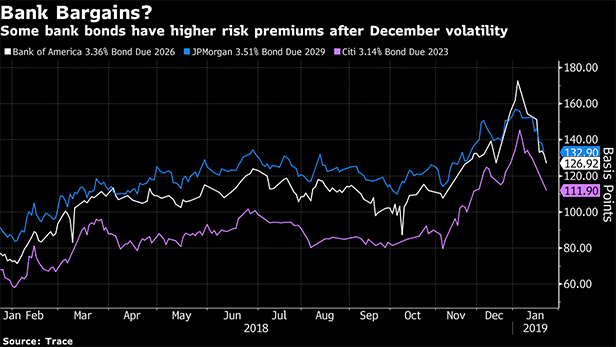The biggest issuers of U.S. corporate bonds are easing up onselling new securities, which could translate to gains forinvestors holding the debt.
|Banks and other financial companies have sold around US$50billion of bonds so far this year, down more than 40 percent fromthe same period a year ago. For the largest U.S. banks, the declinehas been even steeper—they sold just $12 billion of debt afterearnings, about a third of sales at the same point last year.
|Debt sales are falling after banks have largely sold enough debtto meet the requirements of a Federal Reserve regulation, and taxcuts have lifted their cash flow, reducing their borrowing needs.Many foreign banks, typically major January issuers, have sat outamid Brexit jitters and rising hedging costs incurrency markets. U.S. and foreign financial companies representabout a third of the $5 trillion high-grade bond market.
|“Issuance will be more strategic and more opportunistic,” saysRobert Smalley, a credit desk analyst at UBS Group AG. While lowerissuance from bank holding companies was widely expected in themarket, “once you see it in black and white it finally hits home,”he says.
|That could translate to gains in bank bonds for the year, atleast based on risk premiums, after the securities weakened at theend of 2018. Strategists at research firm CreditSights called thebonds of large U.S. banks a top trade for 2019, thanks to muted newissuance and the lenders' strong balance sheets. Bonds tied tobanks returned 1.22 percent through Wednesday, compared with 1.05percent for broader investment-grade securities.
|
Banks are just one part of what is likely to be a big slowdownfor new corporate bond issuance in 2019, as tax cuts give companiesmore cash flow to pay down debt. Investment-grade corporate bondsales so far this year have fallen more than 15 percent from thesame period last year, according to data compiled by Bloomberg.
|Analysts at JPMorgan Chase & Co., Bloomberg Intelligence,and Nomura Holdings forecast that overall issuance this year willfall by about 10 percent. Declining sales of new securities couldbe one of the biggest near-term tailwinds for a market that facesserious long-term risks, including the fact that around half ofoutstanding investment-grade debt is in the tier just abovejunk.
|The few banks that have tapped the market have been greeted withfervid investor demand. A $500 million bond from Bank of Americafor socially beneficial projects sold Tuesday drew 11 times theorders it needed, according to people familiar with the matter. Thedemand let the lender sell the debt with lower risk premiums thanexisting bonds. And JPMorgan drew $6.5 billion in orders for a $2billion unsecured bond sale this week.
|Similar hunger for a Morgan Stanley bond last week meant thebank paid a yield just 0.01 percentage point above that of itsexisting debt for its new securities. The average for this year iscloser to 0.12 percentage point.
|Declining overall company debt issuance is at least part of whya growing number of strategists at banks including Bank of AmericaCorp., Morgan Stanley, and JPMorgan Chase say it's time to startbuying corporate bonds again. A Bank of America survey releasedthis week said that around 38 percent of high-grade investors ownedmore of the debt than their benchmark indexes in January, aboutdouble the proportion in November, because many money managers viewthe debt as relatively cheap.
|Matt Brill, a senior portfolio manager at Invesco, which manages$888 billion, says bank bonds still look like a good buy becausemost of the securities haven't fully recovered from December'smarket gyrations. But banks have spent years building their capitallevels, and any upcoming slowdown in economic growth won't likelyhave much impact on lenders' ability to pay their debt obligations,he says.
|“There still is value in the banking space,” Brill says. “Thecredit market has been very strong, and demand for bank paper hasbeen there. Investors have gotten the impression quite early thatbank issuance will be underwhelming.”
|For years, banks have issued large amounts of debt at theirparent companies to meet the requirements of a regulatory ruleknown as total loss-absorbing capacity, or TLAC. In times ofcrisis, the parent-company debt would turn into equity to helpfinance a new, healthy version of the bank. The biggest U.S. banksissued more than $660 billion of this debt between 2015 and 2018,according to Bloomberg data, and have met their requirements.
|“With TLAC, the buildup is done,” says Pri de Silva, an analystat CreditSights. “Banks still need to remain in compliance. Theywill be regular issuers on and off.”
|Now more bank bond issuance is likely to come in shorter-termdebt, maturing in three years or less, sold by the operatingbanking unit, Bloomberg Intelligence analyst Arnold Kakuda wrote ina note on Tuesday. The regulated banks can often borrow cheaperthan their holding companies. Overall issuance ofdollar-denominated bank bonds are likely to fall again in 2019after declining 13 percent to $359 billion last year. That, alongwith banks' healthy capital positions, should help risk premiums onthe debt compress, says Jon Curran, a portfolio manager at AberdeenStandard Investments, which manages about $736 billion.
|“They're certainly not giving away these deals,” Curran says.He's been selectively buying bank bonds when he can find value.“It's a nice validation. Banks stand on firm fundamentalfooting.”
||
From: Bloomberg
|Copyright 2019 Bloomberg. All rightsreserved. This material may not be published, broadcast, rewritten,or redistributed.
Complete your profile to continue reading and get FREE access to Treasury & Risk, part of your ALM digital membership.
Your access to unlimited Treasury & Risk content isn’t changing.
Once you are an ALM digital member, you’ll receive:
- Critical Treasury & Risk information including in-depth analysis of treasury and finance best practices, case studies with corporate innovators, informative newsletters, educational webcasts and videos, and resources from industry leaders.
- Exclusive discounts on ALM and Treasury & Risk events.
- Access to other award-winning ALM websites including PropertyCasualty360.com and Law.com.
*May exclude premium content
Already have an account? Sign In
© 2024 ALM Global, LLC, All Rights Reserved. Request academic re-use from www.copyright.com. All other uses, submit a request to [email protected]. For more information visit Asset & Logo Licensing.







